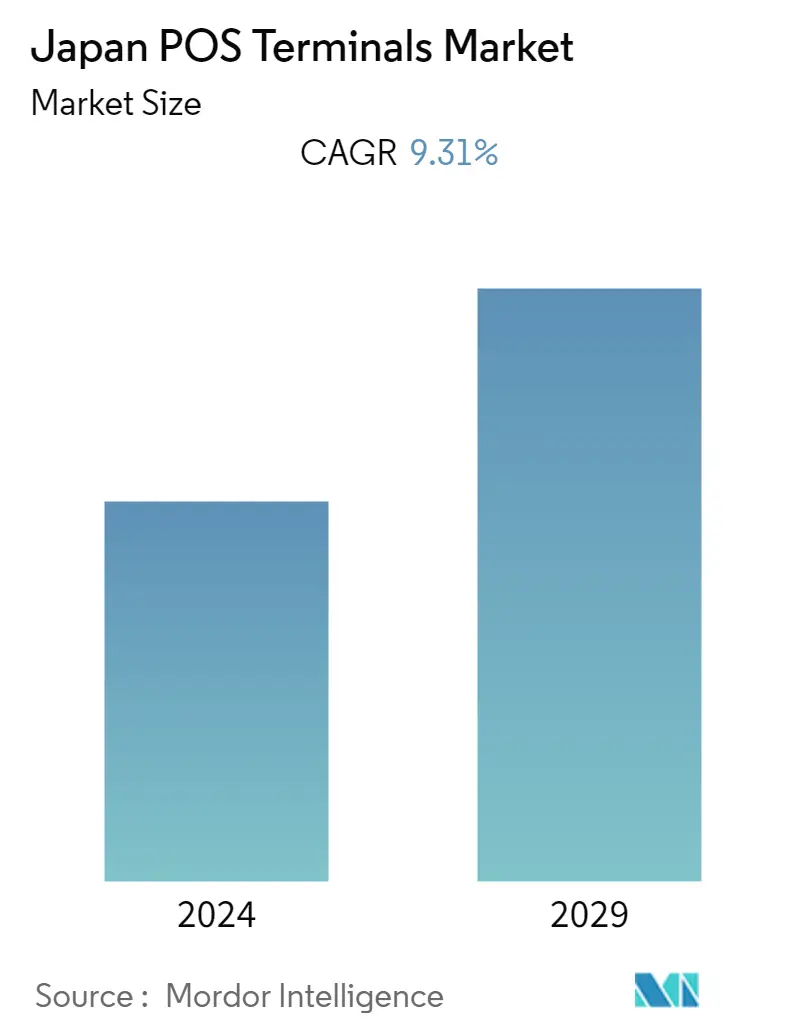Market Size of Japan POS Terminals Industry

| Study Period | 2019 - 2029 |
| Base Year For Estimation | 2023 |
| Forecast Data Period | 2024 - 2029 |
| Historical Data Period | 2019 - 2022 |
| CAGR | 9.31 % |
| Market Concentration | Medium |
Major Players
*Disclaimer: Major Players sorted in no particular order |
Need a report that reflects how COVID-19 has impacted this market and its growth?
Japan POS Terminals Market Analysis
The Japanese POS Terminal market is valued at 114.32 thousand units in the previous year and is expected to register a CAGR of 9.31% during the forecast period to become 183.82 thousand units by the next five years. The POS terminal market has grown significantly over the past few years, owing to its ability to offer an increased return on investment and ease of access. POS systems that facilitate transactions from the central component of businesses across industries, like retail, hospitality, transportation, and banking, have gained importance in companies of small and big sizes over the years.
- POS terminal systems have grown from transaction-oriented devices to systems that support and integrate into firms' CRM and other financial solutions in the present market scenario. Companies could use collected transactional data from POS terminals to provide business insight in this case.
- Vendors have supported consistent development in mobile payments, particularly smartphone-enabled QR-code payments. Similarly, progress has been made in other sectors of the ecosystem. Cashless projects are making tremendous progress, with the establishment of a government-funded biometrics infrastructure and a rise in the use of EMV-based contactless payments (or NFC Pay as it is known in Japan). Such trends are expected to act as major catalysts for the increase in the adoption of POS terminals in the country.
- Modern POS terminals reduce the cost of setup, deployment, maintenance, and power consumption over time, leading to the total cost of ownership. Various vendors offer modular POS terminals with attributes such as touchscreen displays and low power consumption, which helps in reducing the overall cost of ownership. Companies such as Sharp Electronics, NEC Corporation, and others offer fixed POS solutions with touchscreen displays and robust processors that help improve operations and reduce failures. In addition, the POS offered by Aures comes with fanless temperature control to reduce the number of moving parts in a terminal.
- The expanding digitization of the economy and the increasing application of POS platforms across sectors will drive the POS Terminals market forward. Growing awareness of the effectiveness of POS displays, an increase in retail chains, and the increasing usage of near-field communication-enabled systems are all likely to help the market's growth.
- The utilization of digital and electronic payment techniques, like debit and credit cards, e-wallets, and smart cards, such as Pasmo and Suica, is extensively growing among younger buyers and in major urban areas. They provide a convenient and effective method for consumers to conduct transactions without requiring physical currency or a credit card. Additionally, they are extremely safe and enable users to monitor their expenditures. Japan's transportation enterprises created Suica and Pasmo smart cards, which can be utilized for transportation, automated vending machines, and in-store acquisitions.
- Moreover, the government of Japan has been taking proactive initiative and striving to establish a supportive atmosphere for the growth of cashless payments in Japan by implementing a "Cashless Vision" with the aim of raising cashless transactions to 40% by 2025 and 80% by the long run. They have also introduced a reward system, which increased cashless payments adoption in 2019. The pandemic also boosted non-cash payments as consumers avoid contact during transactions.
- Similarly, in January 2022, Mastercard announced a strategic partnership with Wakayama Prefecture to leverage its global standard payment network to boost the development of the tourism sector and accelerate the cashless transaction infrastructure and digital transformation for small and medium businesses in the prefecture.
- This partnership will encourage the adoption of global standard cashless payment systems, which involve the integration of contactless payments using IC cards and smartphones. Moreover, both parties will promote effective payment procedures at businesses in the region through the utilization of technologies like virtual cards.
- The COVID-19 pandemic substantially altered how customers purchase, affecting various business segments. The pandemic had a significant impact on the retail industry. Consumers also increased their usage of diverse sales tactics, such as curbside pickup, virtual consultations, contactless payment, social commerce, or social media purchasing. According to the most recent retail experts and shopper surveys, this new habit is projected to persist during the projection period. Such changes have influenced POS terminal demand.
